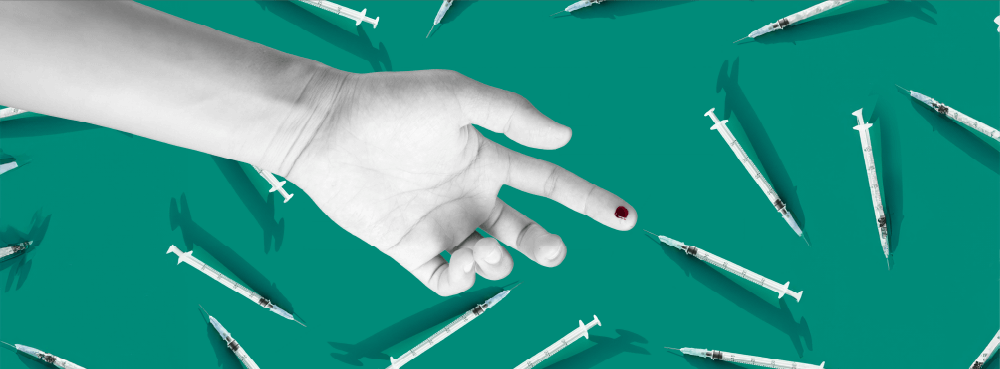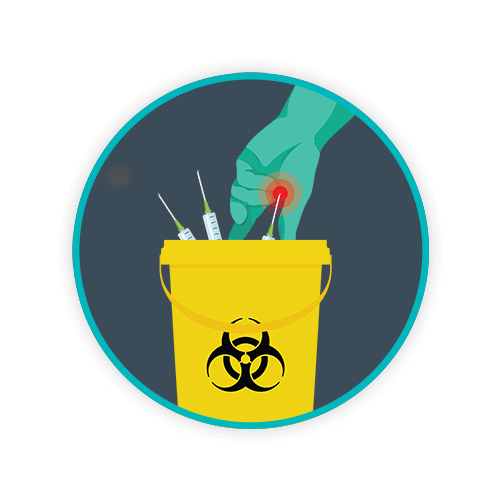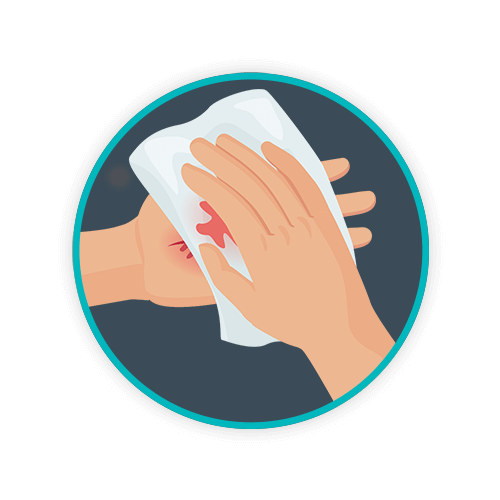What Diseases Can Result From a Sharps Injury?

The healthcare industry is ever-changing and there’s always something new to be inspired by or excited about.
But do you know what isn’t new? Sharps injuries. And neither are bloodborne viruses…
Sharps, including syringes, scalpels, needles, lancets, and broken glass, have for a long time posed a significant risk to healthcare workers as a dangerous potential source of infection in the healthcare setting.
It’s crucial to be aware of the potential diseases that can result from a sharps injury – let’s take a look at some of the common diseases associated with needlestick injuries and highlight the importance of proper sharps waste management.
TOPICS WE WILL COVER:
1 / Where are bloodborne viruses encountered?
2 / What diseases can result from a sharps injury?
3 / Early detection of bloodborne pathogens is crucial.
4 / Who is at risk of needlestick injuries?
5 / The role of sharps waste management.
6 / Are you looking to reduce infection risk in your facility?
7 / Skip the reading, get to the point…
Where Are Bloodborne Viruses Encountered?
The Health and Safety Executive (HSE) defines bloodborne viruses (BBVs) as “viruses that some people carry in their blood and can be spread from one person to another.”
Blood and bodily fluid exposures (BBFE) may occur via sharps injuries (e.g. needles, scalpels) or mucocutaneous exposures (e.g. eye, mouth) and there are more than 60 pathogens that such exposure has the potential to transmit – posing significant risk and psychological stress to healthcare workers.
Another area that poses a risk of blood and bodily fluid exposure is the improper handling of clinical waste – a type of waste that all healthcare workers encounter each day.
See the Royal College of Nursing’s Blood and Bodily Fluid Exposure (BBFE) report for more information on current BBFE incidence, experiences, and opinions.
What Diseases Can Result from a Sharps Injury?
The main risk from a sharps injury is the potential exposure to infections such as bloodborne viruses (BBV) which can occur where the injury involves a sharp contaminated with blood or bodily fluid from an infectious patient.
Numerous pathogens can potentially be transmitted from such exposures but the bloodborne viruses of most concern are:
- Hepatitis B
- Hepatitis C
- HIV
The risk of disease transmission makes sharps injuries cause anxiety and stress to the many thousands who receive them each month, taking an emotional toll.
Hepatitis B
Hepatitis B is a viral infection that affects the liver. It usually only lasts for a few months but some people can have chronic hepatitis B which is long-term and can cause liver damage and an increased risk of liver cancer.
Hepatitis C
Hepatitis C is a viral infection that affects the liver and causes it to swell. It can cause both acute (short-term) or chronic (long-term) illness and can have life-threatening outcomes like liver damage and scarring, liver failure, and an increased risk of liver cancer.
HIV
HIV (human immunodeficiency virus) is a viral infection that attacks the immune system, making it more difficult to fight everyday infections and other illnesses and without treatment can lead to severe immune system damage, increasing your risk of further infections and certain cancers.
Other Bloodborne Pathogens
As well as hepatitis B, hepatitis C, and HIV, there are other bloodborne pathogens that you may be exposed to as a result of a sharps injury. These include pathogens such as syphilis, malaria, cytomegalovirus (CMV), human T-lymphotropic virus (HTLV), and Epstein-Barr virus.
Whilst the risk of transmission for these pathogens may be lower than the aforementioned ones, it’s still vital to take every precaution to prevent infection.

Early Detection of Bloodborne Pathogens is Crucial
One of the biggest reasons you should report a needlestick injury is to ensure the early detection of bloodborne pathogens. This provides the opportunity to begin any necessary treatments as soon as possible to help prevent long-term complications including the potential future spread of infections.
It’s an employer’s duty of care (outlined in Sharp Instruments in Healthcare Regulations 2013) to ensure that any staff member who suffers from a sharps injury is given immediate access to medical advice.
Despite the high number of needlestick injury rates with few leading to serious infections, every sharps injury should be taken seriously as the effects and concerns about consequences including the adverse side effects from post-exposure prophylaxis greatly impact injured healthcare workers.
Who Is at Risk of Needlestick Injuries?
The people most at risk of needlestick injuries are healthcare workers who handle sharps directly. However, the risk of injury does extend beyond those directly handling sharps to include other healthcare workers who may inadvertently be exposed due to improper storage or disposal practices.
The risk to healthcare workers includes those exposed to patients, blood, and bodily fluids and encompasses various roles within the healthcare setting like nurses, clinicians, doctors, students, domestic, and portering staff.
Some procedures pose a higher risk too, including intra-vascular cannulation, venepuncture and injections, the use of IV cannulae, and needles such as winged steel-butterfly needles, syringes, and phlebotomy needles.
This inherent risk makes it an essential aspect of health and safety within any healthcare environment to understand how to protect healthcare workers from sharps injuries.

The Role of Sharps Waste Management
Prevention is better than cure, and this is especially true when it comes to needlestick injuries.
The Royal College of Nursing’s Sharps Safety Guidance identified 32% of all sharps injuries as being disposal-related – this highlights the importance of ensuring you’re using the safest containers for disposal, in line with the hierarchy of controls.
That’s a staggering statistic for disposal alone!
When you opt for a sharps waste management system designed for safety and infection prevention, not only will you be helping to prevent injuries but you’ll also be mitigating the risk of disease transmission amongst healthcare workers.
Are You Looking to Reduce Infection Risk in Your Facility?
At Sharpsmart, we understand the importance of infection prevention and control and our solutions always reflect our mission to make healthcare safer.
We didn’t only create the world’s safest sharps waste disposal option, but we also provide free ongoing resources for preventing needlestick injuries in the healthcare environment.
If you’d like to learn more about the safety benefits of our reusable containers and how together we can prioritise the prevention of sharps injuries, or if you’re looking for guidance on healthcare waste management that minimises infection risk, please don’t hesitate to get in touch.
Blog Summary
Welcome to our digestible short-form version of the blog!
This blog delves into the persistent threat of sharps injuries in the healthcare industry and emphasises the importance of proper management to mitigate risks. Here are the kye takeaways…
Diseases Resulting from Sharps Injuries
Sharps injuries can lead to exposure to serious bloodborne viruses. Hepatitis B, Hepatitis C, and HIV are major concerns, but there are other pathogens like syphilis and malaria to be wary of – causing anxiety and stress among healthcare workers.
Early Detection is Crucial
Immediate reporting of needlestick injuries allows for early detection of bloodborne pathogens, facilitating timely treatment and helping to prevent long-term complications.
Who’s at Risk?
While healthcare workers directly handling sharps are most at risk, others in the healthcare environment can also be affected due to improper waste handling and disposal practices.
The Role of Sharps Waste Management
Prevention is key, and effective sharps waste management, including the use of proper disposal containers plays a pivotal role in preventing sharps injuries and mitigating the risk disease transmission.
Reducing Infection Risk
Sharpsmart’s reusable sharps waste containers prioritise safety and infection prevention, we also provide free ongoing resources and guidance to minimise sharps injuries and infection risks.
The short version only whets the appetite, if you fancy reading the full blog and discovering more, click here to head back to the top…
Let's Talk!
Your time is valuable, and we don’t want to play hard to get. You can either phone us directly on the details listed on our contact page, or feel free to fill out this short form and one of our team members will get back to you as quickly as possible.

